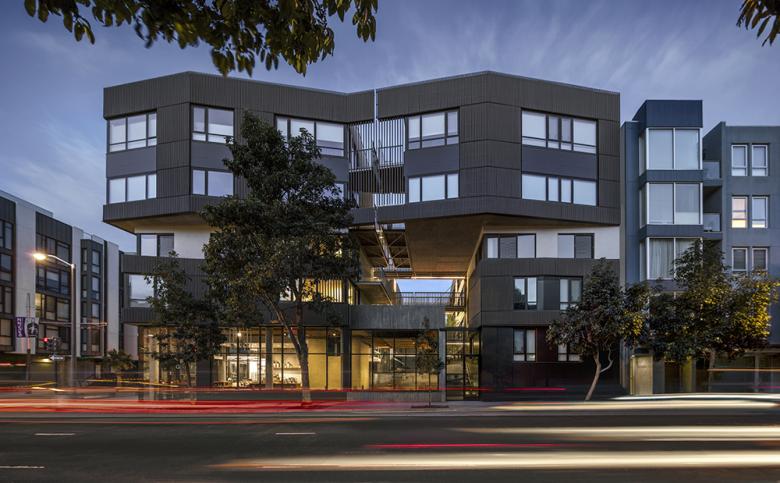Fougeron Architecture
400 Grove
Fougeron Architecture
9. January 2017
Behind the serrated façade of 400 Grove in San Francisco's Hayes Valley sits a secret – a green secret. Inspired by the central mews typology, Fougeron Architecture placed a bamboo garden that each of the 34 residential units look upon. The plant's stalks are reiterated in the wood-dowel façade, which sequesters carbon and gives the building a striking street presence. The architects answered a few questions about the multi-family project.
What were the circumstances of receiving the commission for this project?
We were hired by the client who was looking for an innovative design.
Please provide an overview of the project.
400 Grove introduces 34 residences in the heart of Hayes Valley, continuing the neighborhood’s rise as a vital, walkable neighborhood. Its prominent site at the corner of Grove and Gough streets, is one of several sites created by the removal of the Central Freeway in 2003, as part of a bold initiative to reconnect Hayes Valley with surrounding neighborhoods.
What are the main ideas and inspirations influencing the design of the building?
400 Grove’s design references the central mews typology, which sets row houses around an internal alley that provides car access as well as a place where neighbors meet. This contemporary take replaces the alley with a landscaped common area accessible only to bicycles and pedestrians, strengthening the community focus of the open space. Its faceted facades echo an earlier tradition: the classic San Francisco bay windows prevalent in the area. The modern reinterpretation creates a waved facade with windows angled to capture views of Hayes Valley’s bustling street scene and surrounding hillside neighborhoods.
How does the design respond to the unique qualities of the site?
400 Grove is on a unique site: a vacuum embedded into a community. The site had been created by the removal of the Central Freeway in 2003. The building was set on a true infill site. The project had to feel modern but also intrinsic to its environment: like a permanent structure, stitched into the fabric of the neighborhood.
Was the project influenced by any trends in energy-conservation, construction, or design?
Every aspect of the project was considered for its efficiency and sustainability. Fougeron Architecture used sustainably-sourced redwood wood dowels on the façade to sequester carbon. All wood contains carbon dioxide and when used in long-term applications such as building, this carbon is prevented from reentering the earth’s atmosphere. Choices like the façade or the use of reclaimed components incorporated into concrete structure are simple but innovative ways to incorporate sustainability.
Sustainability decisions had to be made meticulously. The lush central courtyard requires minimal irrigation as rainwater flows through planters rather than landing in a storm drain. The existence of the courtyard allows maximum southern exposure for all units. Every dwelling unit is designed to maximize energy efficiency. Each is outfitted with Energy Star appliances, low-VOC finishes, reclaimed wood flooring and most importantly, double-aspect windows to reduce electrical lighting load and winter heating. With these characteristics, 400 Grove exceeds Green Point compliance by 230%, equivalent to LEED Gold.
What products or materials have contributed to the success of the completed building?
The wooden dowels are the most striking feature of the building. They serve to as rain screen material on the street facades, tracing the facetted walls. The same redwood dowels are used again as guardrails for the stairs and bridges of the courtyard and also routed with an LED light to serve as lighting within the courtyard. The choice to use wood came through an evaluation of various materials for their sustainable, contextual, and resiliency qualities. Wood is rooted in the vernacular of San Francisco architecture, but it is used here in unconventional form.
Email interview conducted by John Hill.
Site plan
Floor plans
Diagram - open space and portal
Section diagram
Facade articulation
400 Grove
2016San Francisco, California
Client
DM Development and DDG
Architect
Fougeron Architecture
San Francisco, CA
Design Principal
Anne Fougeron
Project Team
Todd Aranaz, Megan Hannon
Structural Engineer
Dolmen Structural Engineers Inc.
MEP/FP Engineer
ACIES Engineering
Landscape Architect
Marta Fry Landscape Associates
Lighting Designer
Fougeron Architecture
Interior Designer
Fougeron Architecture
Contractor
Cannon Constructors North, Inc.
Lighting
Klus Lighting
Metal Cladding
Alumawall
Dowel Façade
The HC Brock Company
Site Area
11,275 sf (0.26 acres)
Building Area
34,000 sf (residential), 2,070 sf (commercial)
Photographs
William Timmerman Photography
Drawings
Fougeron Architecture
Related articles
-
Spotlight on Italy
on 5/16/18
-
Bologna Shoah Memorial
on 7/20/15
















